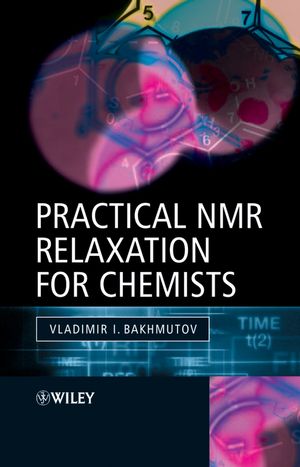Practical Nuclear Magnetic Resonance Relaxation for ChemistsISBN: 978-0-470-09446-4
Paperback
220 pages
January 2005
 This is a Print-on-Demand title. It will be printed specifically to fill your order. Please allow an additional 10-15 days delivery time. The book is not returnable.
Other Available Formats: Hardcover
|
||||||
1. How and Why Nuclei Relax.
1.1. Nucleus in the magnetic field.
1.2. Spin-lattice and spin-spin nuclear relaxation.
1.2.1. Macroscopic magnetization: relaxation times T1 and T2.
1.3. Molecular motions as reason of nuclear relaxation.
1.3.1. Correlation times and activation energies of Molecular Motions.
1.3.2. Isotropic and anisotropic molecular motions.
1.4. Bibliography for Chapter 1.
2. How to Measure the NMR Relaxation Times.
2.1. Exponential and non-exponential nuclear relaxation.
2.2. Measurements of spin-lattice relaxation times.
2.3. Measurements of selective and bi-selective T1 times.
2.4. Determinations of T1( and T2 times.
2.5. Preparation of samples for relaxation experiments.
2.6. Bibliography to Chapter 2.
3. Errors in Determinations of Relaxation Times.
3.1. Instrumental errors.
3.2. Incorrect parameters for T1, T2 measurements and T1, T2 calculations.
3.3 Coupled nuclear relaxation.
3.4. Chemical exchanges.
3.5. Bibliography to Chapter 3.
4. NMR Relaxation by Dipole-Dipole and Quadrupole Interactions.
4.1. The intramolecular dipole-dipole relaxation: homo- and hetero-nuclear dipolar coupling and the spectral density function.
4.2. Haw to reveal the presence of the dipolar mechanisms.
4.2.1. NOE as a test for dipole-dipole nuclear relaxation.
4.2.2. Evaluations of the dipolar contributions from selective and non-selective T1 times.
4.3. Intermolecular dipole-dipole interactions.
4.4. Electric field gradients at quadrupolar nuclei.
4.5. Nuclear quadrupole coupling constant as a measure of the electric field gradient.
4.6. Quadrupole relaxation.
4.7. Bibliography to Chapter 4.
5. Relaxation by Chemical Shift Anisotropy, Spin-Rotation Relaxation, Scalar Relaxation of the Second Kind and Cross-Mechanisms.
5.1. Relaxation by chemical shift anisotropy.
5.2. Spin-rotation relaxation.
5.3. Interference mechanisms of nuclear relaxation.
5.4. The scalar relaxation of the second kind.
5.5 Bibliography to Chapter 5.
6. Nuclear Relaxation in Molecular Systems with Anisotropic Motions.
6.1. Spin-lattice nuclear relaxation in ellipsoid molecules: Temperature dependences of T1times.
6.2. How to reveal anisotropic molecular motions in solutions.
6.3. Nuclear relaxation in the presence of correlation time distributions.
6.4. Bibliography to Chapter 6.
7. 1H T1 Relaxation Diagnostics in Solutions.
7.1. Revealing weak intermolecular interactions by T1 time measurements in solutions.
7.2. T1 studies of exchanges in simple molecular systems.
7.3. Structural 1H T1 criterion.
7.4. Partially-relaxed NMR spectra.
7.5. Bibliography to Chapter 7.
8. Internuclear Distances from the 1H T1 Relaxation Measurements in Solutions.
8.1. X...H distances: metal - hydride bond lengths.
8.1.1. How to determine metal-hydride bond lengths by standard 1H T1 measurements.
8.1.2. Metal-hydride bond lengths by 1H T1sel and 1H T1min times measurements.
8.2. Proton-proton distances by standard T1 measurements.
8.3. H-H distances from T1sel / T1bis measurements.
8.4. H-H distances in intermediates.
8.5. Analyzing the errors in 1H T1 determinations of internuclear distances.
8.6. Bibliography to Chapter 8.
9. Deuterium Quadrupole Coupling Constants from 2H T1 Relaxation Measurements in Solutions.
9.1. How to determine DQCC values.
9.2. DQCC values from the 2H T1 times measurements in solutions (fast motional regime).
9.3. DQCC values via 2H T1min measurements in solutions.
9.4. Errors in DQCC determinations.
9. 5. Bibliography to Chapter 9.
10. Spin-Lattice 1H and 2H Relaxation in Mobile Groups.
10.1. 1H T1 times and H-H distances in the presence of fast vibrations and librations.
10.2. 1H T1 times and H-H distances in the presence of fast rotational diffusion.
10.3. The spectral density function for high-amplitude librations.
10.4. 900-jumps in four-fold potential.
10. 5. Deuterium spin-lattice NMR relaxation in mobile molecular fragments.
10.6. Bibliography to Chapter 10.
11. Relaxation of Nuclei Other Than 1H and 2H) and Specific Relaxation Experiments.
11.1. Chemical shift anisotropies and nuclear quadrupole coupling constants from T1 times of heavy nuclei in solutions.
11.2. Multinuclear relaxation approaches to complexation, association and H-bonding.
11.3. Na relaxation in solutions of complex molecular systems.
11. 4. Character of molecular motions from 17O and 2H T1 relaxation in solutions.
11.5. 2D T1 and T1( NMR experiments.
11.6. Chemical exchanges in complex molecular systems from 15N nuclear relaxation in solutions.
11.7. R1/R2 method.
11.8. Cross-correlation relaxation rates and structure of complex molecular systems in solutions.
11.9. Variable - field relaxation experiments.
11.10. Bibliography to Chapter 11.
12. Paramagnetic NMR Relaxation.
12.1. Theoretical basics of the paramagnetic relaxation enhancement.
12.2. Paramagnetic relaxation rate enhancements in the presence of chemical exchanges.
12.3. Structural applications of paramagnetic relaxation rate enhancements.
12.4. Kinetics of ligand exchanges via paramagnetic relaxation rate enhancements.
12.5. Longitudinal electron relaxation time in paramagnetic centers from variable-high field NMR experiments.
Bibliography.
Concluding Remarks.
Index.



